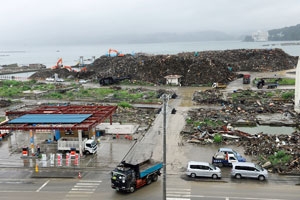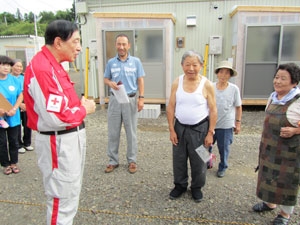Japanese Red Cross helps tsunami and nuclear disaster survivors to face up to an uncertain future
2011/09/09

Six months on from the Tohoku earthquake and tsunami that devastated huge areas of north-eastern Japan, the future remains uncertain for thousands of survivors, particularly those displaced by contamination from the damaged Fukushima nuclear reactor.
“Given the enormous scale of the destruction and the massive area affected, this will be a long and complex recovery and reconstruction operation”, says Tadateru Konoe, President of the Japanese Red Cross Society. “It will take at least five years to rebuild, but healing the mental scars could take much longer”.
The Japanese Red Cross has played a key role in emergency response and recovery efforts. More than 800 medical teams were deployed immediately after the disaster to run mobile clinics for survivors. The Red Cross is continuing to provide psychosocial support to people remaining in evacuation shelters and in their homes, especially the elderly.
One of the priorities has been to restore a sense of normality in the lives of people who have lost family members, homes and livelihoods. The Japanese Red Cross has already provided a package of household appliances to 96,000 families who have moved into temporary homes. The programme will be expanded to reach around 110,000 families.
(Photo: Minamisanriku in Miyagi Prefecture. There are an estimated 23.1 million tons of debris which still need to be cleared up.)

Meeting the needs of families evacuated from the vicinity of the damaged nuclear reactor in Fukushima continues to be a major challenge. For now, like the majority of survivors – except for about 6,000 who are still in evacuation centres in the worst-affected prefectures - Ayako Yamada and her family have started a new life in a temporary house. Given the complicated challenges and uncertainty about the future, it’s likely they will remain there for a few years.
“On the one hand we really want to go back, but on the other, we know we can’t, “says Ayako, as she sits sombrely with her mother and son in the family’s new home about 60 km from the damaged reactor. They have been able to pay one brief visit back to their house, now within a 20 km exclusion zone, dressed in protective clothing to retrieve items such as a photo of her deceased father. But that is it.
Red Cross volunteers are organising regular events to make life for survivors like the Yamada family more sociable by helping them get to know their neighbours and preventing a sense of isolation. Also, Japanese Red Cross teams are offering medical assistance and first aid for those in Fukushima making temporary visits back to their homes in the exclusion area. The Red Cross is also planning to provide hospitals in the area with whole-body radiation measuring equipment.
With donations totalling 40 billion yen (410 million CHF, 369 million EUR, 510 million USD) received (of a total 51 billion pledged) by Red Cross Red Crescent societies abroad, another key part of the Japanese Red Cross reconstruction plan is to support the building of temporary hospitals. It’s expected to take around five years for new permanent hospitals to be built as part of the re-building of devastated towns around the disaster area. Such temporary facilities are seen as essential as prefabricated temporary hospitals are already becoming overcrowded.
(Photo: President Konoe recently paid a visit to Fukushima, and had a conversation with those who are displaced from their homes because of the crippled Fukushima Daiichi nuclear power plant.)















